Written by Sig Silber
HEADLINES (Updated 5:53 pm EDT) –
– Heavy rainfall/flash flooding likely in portions of Arkansas tonight
– Extremely critical fire weather risk for Northern Plains/Rockies Wednesday afternoon and evening
– Severe weather risk in the Mid-Atlantic tonight and Thursday

This article provides continuous updates for a variety of Weather and Weather-Related Threats as well as a general weather forecast. These are “Live” maps that continually update. Please pay attention to the Mesoscale Events maps — Mesoscale Events are potentially life-threatening situations.
Please share this article – Go to the very top of the page, right-hand side for social media buttons. Also, feel free to send this email to anyone you feel will benefit from it.
For those interested in longer-term forecasts, we just published the new NOAA Seasonal Outlook and it can be accessed here.
Readers can scan through this article or jump to where they want to go via the links to the right. To get back to the Directory, hit the back arrow at the top of the URL bar on your screen. But in many cases, one of my Editors has graciously inserted a Return to Directory link to click so that is even easier. This is so high tech that I hardly believe it. |
|
CONUS Focal Points
Short Range Focal Points
Short Range Forecast Discussion NWS Weather Prediction Center College Park MD – 334 PM EDT Wed Sep 02 2020
Valid 00Z Thu Sep 03 2020 – 00Z Sat Sep 05 2020
…Heavy rainfall/flash flooding likely in portions of Arkansas tonight…
…Extremely critical fire weather risk for Northern Plains/Rockies Wednesday afternoon and evening.…
…Severe weather risk in the Mid-Atlantic tonight and Thursday…
Most of the rainfall during the next couple of days will occur along a front at the leading edge of an upper level trough, between the Southern Plains and the Northeast. Scattered to numerous instances of flash flooding are expected between the Southern Plains and Arkansas; a High Risk of Excessive Rainfall exists for portions of Arkansas tonight, where grounds have become quite saturated over the past few weeks. The flash flood/excessive rainfall risk slowly fades in that region on Thursday and Friday. A Slight Risk for severe weather exists tonight and on Thursday for portions of the Mid-Atlantic states farther up the front, on the east side of the upper level trough. The Slight Risk area for Thursday has an embedded Enhanced Risk area over much of the Del-Mar-Va region.
Temperatures are expected to rise across the West and East Coasts over the next couple of days. Upper level high pressure building in the west will contribute to temperatures being increasingly hotter than average there, while warm air will surge north along the East coast ahead of the approaching low pressure system. Record high temperatures are expected across the West on Friday while the Florida Peninsula swelters under near record breaking heat through Friday. Excessive Heat Watches and Warnings are currently in effect for much of California and into the Desert Southwest. Record warm low temperatures are most likely in and near the Carolinas through Friday. Cool air will surge south and into the Northern Plains and Upper Midwest on the backside of a low pressure system. Due to dry and breezy conditions, much of the Northern Rockies and Plains are under an area of elevated fire weather risk. Extremely critical fire weather conditions are likely along the foothills of the Northern Rockies and into the Northern High Plains this evening.
We try to keep this up to date but if is not you can find the updated version here.
When you click on this image it takes you to the SPC Fire Warning Page and you get a set of maps for Days 1, 2, 3 – 8, etc. You can then click on those for more detailed information. The map is a bit blurry as I tried to make it a bit larger than the map provided by NOAA but should be able to see where the current wildfire risks are. But if you click on this map, you will get to see three maps that show the risk for different time periods.
Thunderstorm Risk
This should play out something like shown in this 60 Hour Forecast Animation
Here is a national animation of weather fronts and precipitation forecasts with four 6-hour projections of the conditions that will apply covering the next 24 hours and a second day of two 12-hour projections the second of which is the forecast for 48 hours out and to the extent it applies for 12 hours, this animation is intended to provide coverage out to 60 hours. Beyond 60 hours, additional maps are available at links provided below. The explanation for the coding used in these maps, i.e. the full legend, can be found here although it includes some symbols that are no longer shown in the graphic because they are implemented by color-coding.

The two maps below break it down by day and may be easier to read.
Now, the Day One and Two CONUS Forecasts: These Maps Update Daily.
Day One CONUS Forecast | Day Two CONUS Forecast |
These graphics update and can be clicked on to enlarge. You can see where the weather will be | |
 | |
During the winter much of our weather originates in the Pacific. That is why we pay attention to the near-term history of storms arriving.
Temperature

A version that shows a 20 hour animation and some other views can be found here OR SIMPLY CLICK ON THE IMAGE.
– Return to Directory
Day 3 – 7 Hazards
Hazards:
– Heavy rain across portions of the Central Plains, the Lower Mississippi Valley, the Southern Plains, the Middle Mississippi Valley, the Upper Mississippi Valley, and the Great Lakes, Mon-Tue, Sep 7-Sep 8.
– Heavy rain across portions of the Middle Mississippi Valley, the Great Lakes, and the Upper Mississippi Valley, Sat, Sep 5.
– Flooding possible across portions of the Lower Mississippi Valley and the Southern Plains.
– Flooding occurring or imminent across portions of the Mid-Atlantic, the Lower Mississippi Valley, and the Southern Plains.
– Excessive heat across portions of the Central Great Basin, California, and the Southwest, Sat-Mon, Sep 5-Sep 7.
– Excessive heat across portions of California, Sat-Tue, Sep 5-Sep 8.
– Much above normal temperatures across portions of California, the Pacific Northwest, and the Northern Great Basin, Sat-Wed, Sep 5-Sep 9.
– Much above normal temperatures across portions of California, the Central Great Basin, the Pacific Northwest, the Northern Rockies, and the Northern Great Basin, Sat-Mon, Sep 5-Sep 7.
– Much below normal temperatures across portions of the Central Plains, the Central Great Basin, the Northern Plains, the Northern Rockies, the Central Rockies, and the Northern Great Basin, Tue-Wed, Sep 8-Sep 9.
– Much below normal temperatures across portions of the Central Plains, the Central Rockies, the Northern Plains, the Southern Rockies, the Upper Mississippi Valley, and the Southern Plains, Wed, Sep 9.
– Heavy rain across portions of the Alaska Panhandle and mainland Alaska, Sun-Tue, Sep 6-Sep 8.
– Heavy rain across portions of mainland Alaska, Sun-Mon, Sep 6-Sep 7.
– High winds across portions of mainland Alaska, Sun-Mon, Sep 6-Sep 7.
Detailed Summary:
The medium range period (Sept. 5-9) can be summarized by an expansive upper level ridge along the west coast of North America, an amplifying downstream trough over the Canadian Prairies and central U.S., and a far reaching ridge across the North Atlantic. The resulting temperature disparity across the Lower 48 will be quite pronounced with more autumn-like temperatures making their first appearance of the season in the northern High Plains and Rockies. A few locations may even have a shot of seeing patchy frost but most areas should, at minimum, experience much below temperatures. From a hazards perspective, it is the Desert Southwest and throughout California’s Great Valley that stand out most with record breaking high temps likely this weekend and into early next week. The Northwest will also contend with hotter than normal conditions as daily highs make a run at triple digits in the Willamette Valley Sunday and Monday. How long the heat wave persists in the West is likely to be determined based on the position of an intense shortwave trough diving into the Plains early next week. Temperatures should cool down by day 7 in the Intermountain West but the heat may linger along the immediate West Coast. The dome of upper level high pressure over the West unfortunately leads to favorable conditions for ongoing wildfires to rage and potentially the start of new fires. There is the potential by the middle of next week for an upper low over the Great Basin that could minimize the fire weather risk. Expect wildfire smoke and poor air quality to continue throughout the period.
As the pattern becomes increasingly amplified, the threat for heavy rainfall becomes more apparent across the Nation’s Heartland. To start the period, a potent surface low tracking across the Midwest should trigger thunderstorms and showers that could contain excessive rainfall rates. As the upper level ridge builds across the West this weekend, a developing area of low pressure tracking across southern Canada will generate showers and thunderstorms across the Midwest and Great Lakes with heavy rain possible in the Upper Peninsula of Michigan. By the start of next week, an intense upper trough traverses the central U.S. and tap into Gulf moisture. This will lead to a swath of heavy rainfall that could extend from the southern Plains to the Great Lakes. There is also the potential for heavy rainfall in the High Plains and central Rockies, but model spread remains high due to the unclear position of the upper level disturbance. A heavy rainfall hazard may be required should guidance suggest the trough aloft sets up farther west. In fact, enough cold air is in place that the first measurable snowfall of the season could occur in the higher elevations of the Rockies.
The theme of an amplified jet stream pattern also exists over the North Pacific, meaning Alaska will also contend with hazardous weather. A formidable storm system is forecast to track across the Aleutians Sunday and then reach the Bering Sea on Monday, resulting in soaking rainfall from the Aleutians to the Panhandle. This storm contains rich subtropical moisture and upsloping flow, thus increasing the potential for excessive rainfall totals. Multiple inches of rainfall are possible (heaviest amounts in the higher elevations) along with gusty winds and rough seas along the coast. Speaking of gusty winds, winds could become strong over southwest Alaska, thus leading to the issuance of a high wind hazard. Heavy rainfall may linger into next Tuesday but it depends upon how long the fetch of subtropical moisture can persist. The occluded storm system is forecast to take its time leaving northern Alaska Tuesday and Wednesday, keeping a mix of rain and snow showers in the forecast into mid-week.
(This is updated only during the week) Note the first list is weather highlights, this list is hazards. Not sure there is that much of a difference but they come from two different parts of NOAA. The Day 3 – 7 Hazards List does not update on weekends. But it is still useful as it remains valid for the period of time it covers. Of course, all forecasts are subject to change. Later we show a map of the hazards. Perhaps we should show them together.
Click here for the latest complete Day 3 -7 Hazards forecast which updates only on weekdays. It includes the full discussion which I do not update in this article but only present the highlights.
– Return to Directory
Ski Snow Reports
We will resume more detailed coverage when the summer is over. During the summer we might add some drought information in this section.


New Seasonal Outlook Issued August 20, 2020
– Return to Directory
Tropical Events
I am replacing the large with three small maps but you can click on them to get larger versions. Even though they are small maps you should be able to tell if there is activity and If I see activity I will make the map where there is activity full size and when available add other related maps.
| the Central Pacific. | the Eastern Pacific | the Atlantic and the Gulf of Mexico |
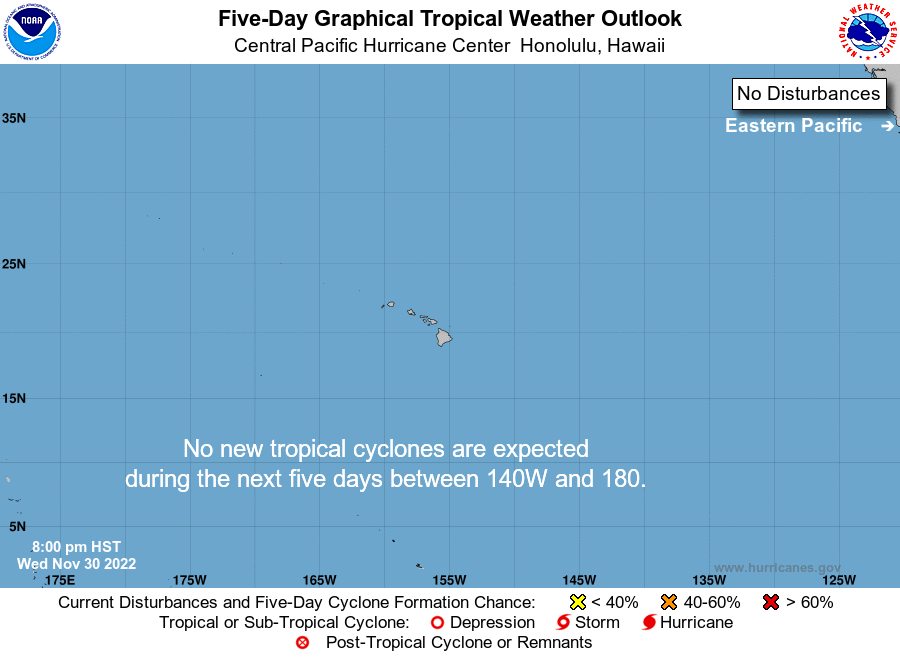 | 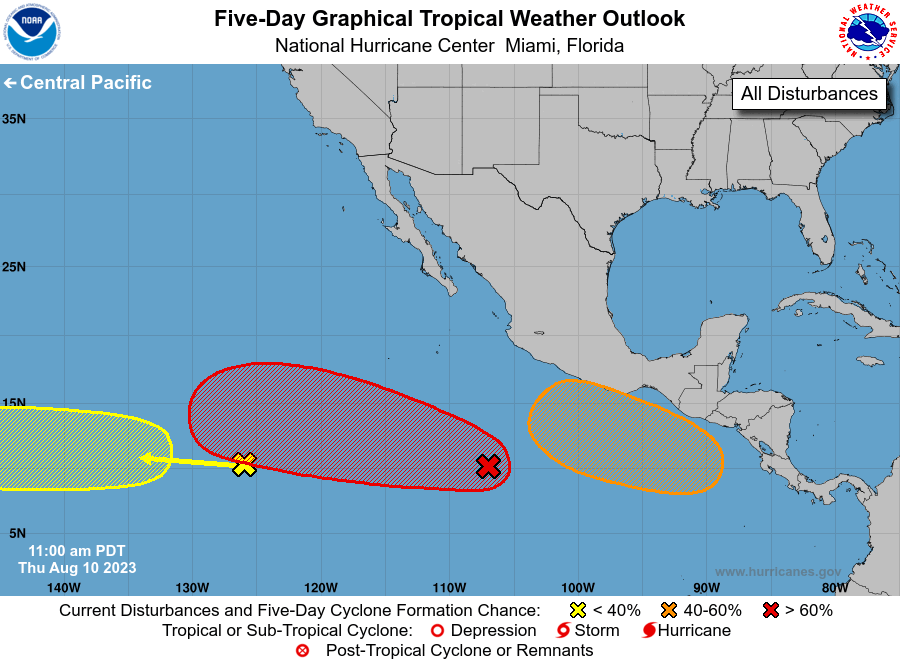 |  |
Atlantic and Gulf of Mexico

![[Image of initial wind radii]](https://www.nhc.noaa.gov/storm_graphics/AT16/refresh/AL162020_current_wind+png/024747_current_wind_sm.png)
And the Eastern Pacific
Updates on individual named storms can be obtained here.
And the Western Pacific



Week Tropical Forecast

– Return to Directory
Intermediate-Term Weather Forecast
And shifting to the Alaska and CONUS Intermediate-Term Weather Forecast showing from left to right, Days 1- 5, 6 – 10, 8 – 14 and Weeks 3 – 4 You can click on these maps to have them enlarge, there are larger versions in the Addendum (More Weather the link is shown at the end of this section, and there are larger versions of these maps in the Addendum. Also, the discussions that go with these forecast maps can be found here (first two weeks) and here (Weeks 3 and 4).
First Temperature
And then Precipitation
For those interested in more detail, there are additional weather maps and information in the MORE WEATHER Addendum. The link to the Addendum is here. |
– Return to Directory
Mesoscale Events
The following map shows where mesoscale events are occurring or forecast. If you do not see any areas highlight on this map than there are no mesoscale events taking place or forecast. A mesoscale event is a very serious situation for a very small area and detailed information is provided for these events when they occur or are forecast. If a mesoscale event is shown, click on the map and more detail on the event will be shown.
Two different parts of the NWS issue this map and they are not always in agreement although they are pretty close. They (Norman Oklahoma and College Park Maryland) issue the alerts when they realize the need, so it is best to look on both maps and click one or both if you see areas highlighted.
This next map showing where “Headlines” have been issued for convection (and an animation of the recent movement of storms) should update and you should be able to click on to get additional details but if it does not update when you click on it, click here.
There is a slight difference between convection and thunderstorms. The below map shows where “Headlines” have been issued for Thunderstorms. You should be able to click on the map to get additional details but if it does not update, you can click here.
The map below shows the current wildfire risk which becomes more significant as we move into Summer. When you click on this image it takes you to the SPC Fire Warning Page and you get a set of maps for Days 1, 2, 3 – 8, etc. You can then click on those for more detailed information. The map is a bit blurry as I tried to make it a bit larger than the map provided by NOAA but should be able to see where the current wildfire risks are. But if you click on this map, you will get to see three maps that show the risk for different time periods.
– Return to Directory
Now the Day 3 – 7 Hazards Outlook Maps

The orange and red outlined areas are what is most concerning of the forecasted Day 3 – 7 Hazards. This graphic does not update during the weekend. There is a discussion that goes with this graphic and you can access that discussion here.
The following is provided to help the reader relate the maps to how NWS will describe an area of the U.S.

– Return to Directory
Now to our More Detailed Weather Report
This graphic is about Atmospheric Rivers i.e. thick concentrated movements of water moisture. More explanation on Atmospheric Rivers can be found by clicking here or if you want more theoretical information by clicking here. The idea is that we have now concluded that moisture often moves via narrow but deep channels in the atmosphere (especially when the source of the moisture is over water) rather than being very spread out. This raises the potential for extreme precipitation events.
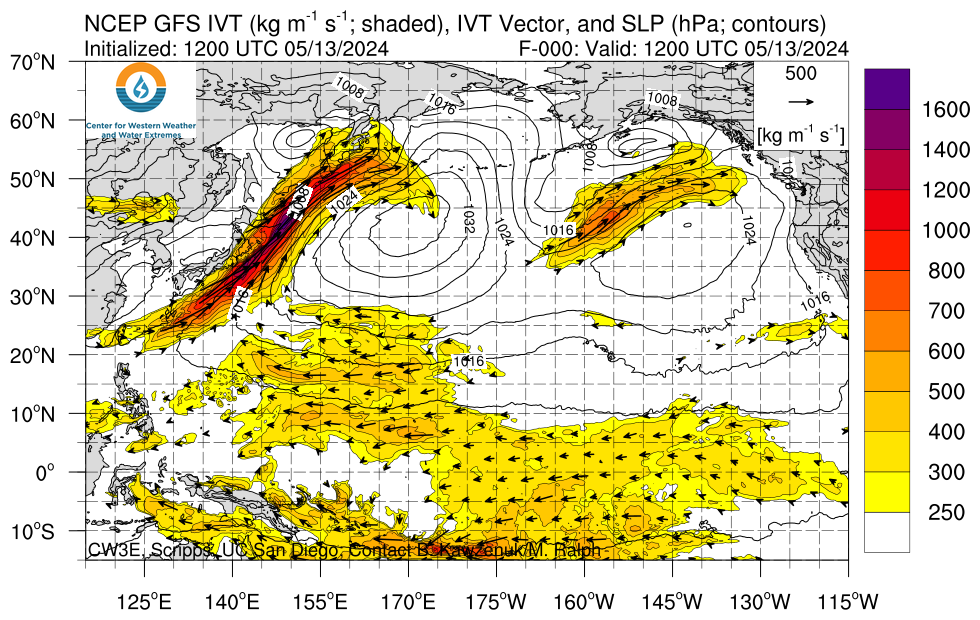
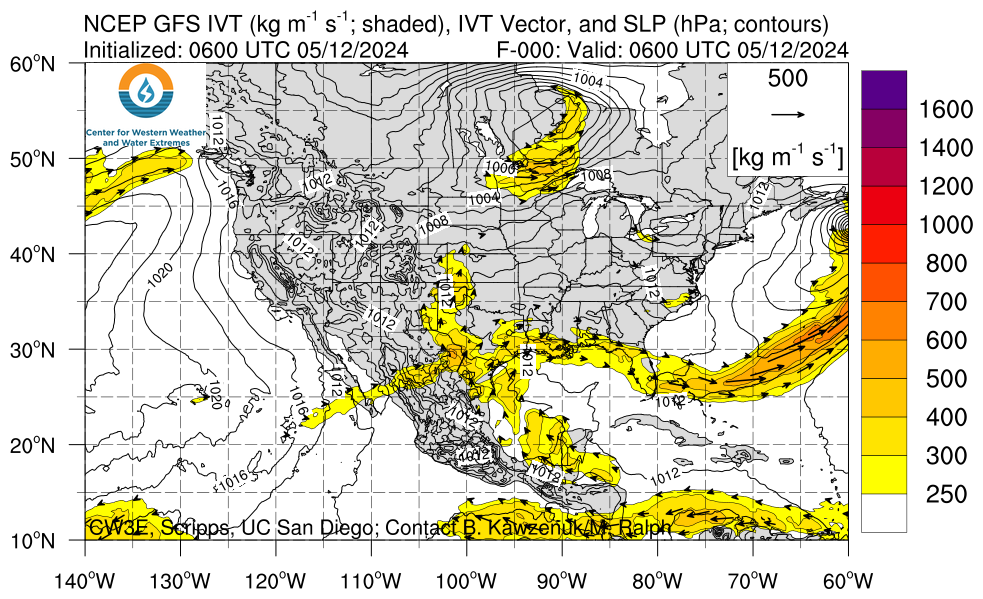
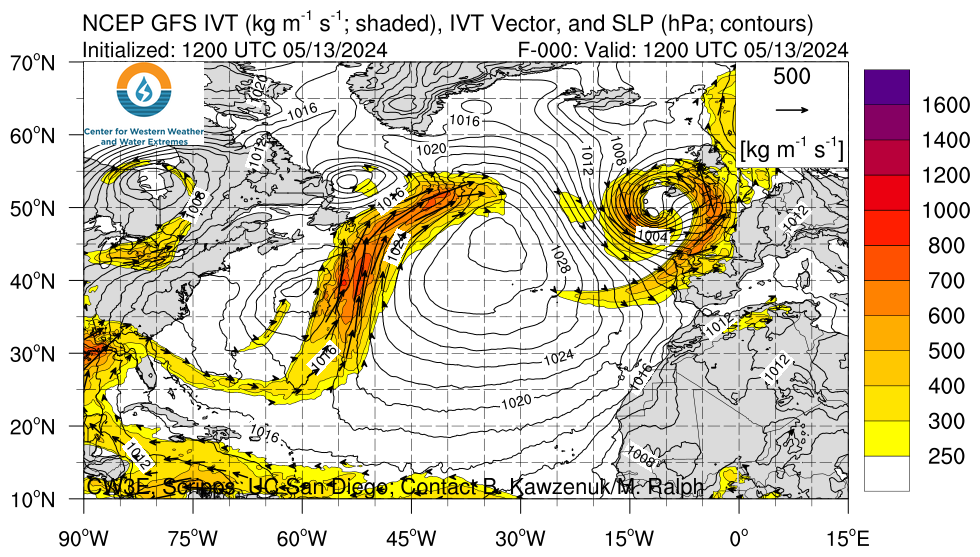
500 MB Mid-Atmosphere View
The map below is the mid-atmosphere 3-Day chart rather than the surface highs and lows and weather features. In some cases, it provides a clearer less confusing picture as it shows only the major pressure gradients. This graphic auto-updates so when you look at it you will see NOAA’s latest thinking. The speed at which these troughs and ridges travel across the nation will determine the timing of weather impacts. This graphic auto-updates I think every six hours and it changes a lot. Thinking about clockwise movements around High-Pressure Systems and counterclockwise movements around Low-Pressure Systems provides a lot of information.


| Day 3 Above, 6 Below | Day 4 Above,7 Below | Day 5 Above. |
 |  |  |
 |  |  |
Here are the precipitation forecasts. First the cumulative for Days 1 – 3

Then cumulative for Days 1 – 5
Then cumulative for Days 1 – 7

Now we look at the forecast for the Maximum Temperature three days out.
Looking ahead to next week.

– Return to Directory
Additional Tools to Obtain Watches and Warnings
| Current watches, warnings, and advisories issued by the agencies of the National Weather Service. Hazards should show up in the various maps but the below links will take you to all outstanding watches and warnings in each category which may include some categories not covered in the various maps or difficult to find. So if there is a category of interest, click on the appropriate link below. |
|
Below you will see a number of different maps that are updated in real-time, making this a “live” report. If a part of one or more of the maps shows an area that is highlighted, you can click on it and get the full current report. By having the reader click on these active situations rather than having GEI do so, you will not miss any events in which you might have an interest and which we had not noticed and the page will not get cluttered with warnings, etc that have since expired.
Our focus here is events that are likely to last in the range of six hours but there can be longer or shorter events that are addressed by the Storm Prediction Center which is the main source of the information in this article. Long-term major events like a Hurricane are more likely to be in a separate article. But that may not always be the case. Since in general, all the links on this page transfer you into the NOAA system, in order to get back into this article you need to either close the tab to which you were transferred or click back on the tab that has this article.
| Live Warning Maps which If Severe Weather is Shown can be Clicked on to get more detail about these events. If there is a current warning shown on the map, click on the map for additional information related to the event. | These maps are updated as risks are identified. |
| This is the current graphic showing any mesoscale discussions (MD’s) which are in effect over the contiguous United States. Please read the description of the purpose of our MD’s for further information. Details on all valid MD’s may be found on our Current Mesoscale Discussions page. |  |
| Convective Outlooks | |
|---|---|
| This is today’s forecast for organized severe thunderstorms over the contiguous United States. Please read the description of the risk categories for further information. You may find the latest Day 1 Outlook available as well as all Outlooks issued today online. | Today’s Outlook |
 | |
| This is tomorrow’s forecast for organized severe thunderstorms over the contiguous United States. Please read the description of the risk categories for further information. The latest Day 2 Outlook is available as well as all Outlooks that have been issued today. | Tomorrow’s Outlook |
 | |
| This is the day after tomorrow’s (day 3) forecast for organized severe thunderstorms over the contiguous United States. Please read the description of the risk categories for further information. The latest Day 3 Outlook is available as well as all Outlooks that have been issued today. | Day 3 Outlook |
 | |
| This is the day 4-8 forecast for organized severe thunderstorms over the contiguous United States. The latest Day 4-8 Outlook is available as well as all Outlooks that have been issued today. Note: A severe weather area depicted in the Day 4-8 period indicates a 30% or higher probability for severe thunderstorms (e.g. a 30% chance that a severe thunderstorm will occur within 25 miles of any point). | Day 4-8 Outlook |
 | |
| The Thunderstorm Outlooks depict the probability of thunderstorms across the contiguous United States in 4 or 8 hour time periods. The probabilistic forecast directly expresses the best estimate of a thunderstorm occurring within 12 miles of a point. The three probabilistic forecast thresholds are 10, 40, and 70 percent. | Thunderstorm Outlook |
 | |
| Fire Weather Outlooks | |
| This is today’s forecast for organized wildfires over the contiguous United States. Please read the description of the risk categories for further information about this product. | Today’s Outlook |
 | |
| This is tomorrow’s forecast for organized wildfires over the contiguous United States. Please read the description of the risk categories for further information about this product. | Tomorrow’s Outlook |
 | |
| This is day 3-8 forecast for organized wildfires over the contiguous United States. Please read the description of the risk categories for further information about this product. | Day 3-8 Outlook |
 | |



























